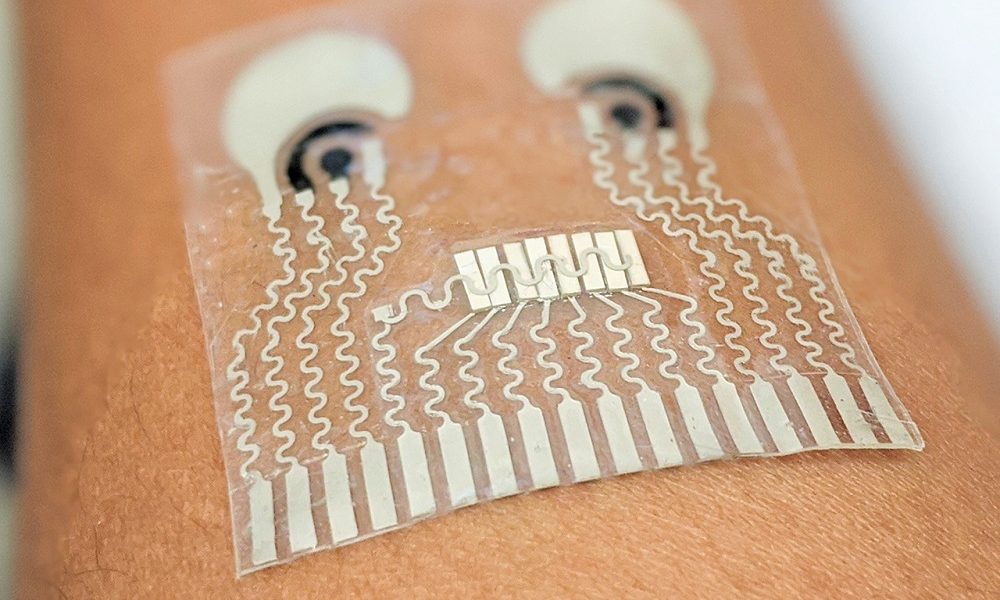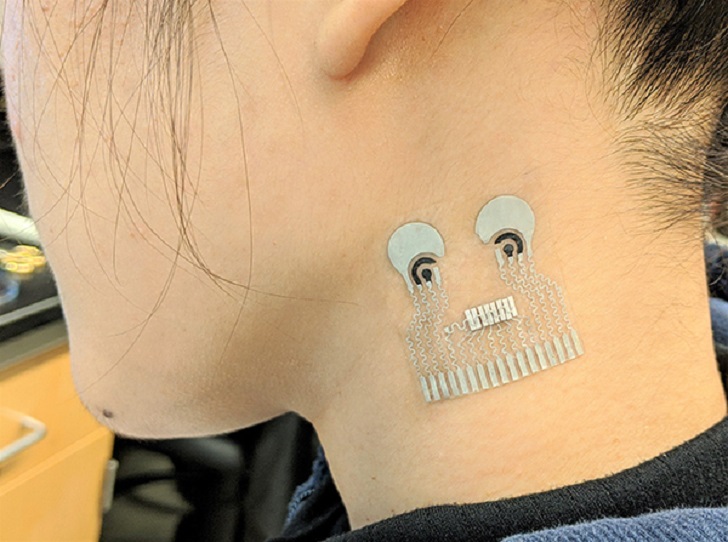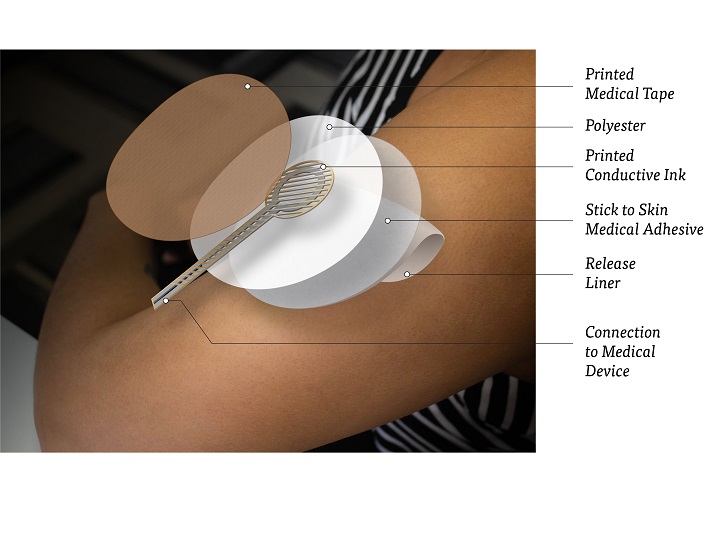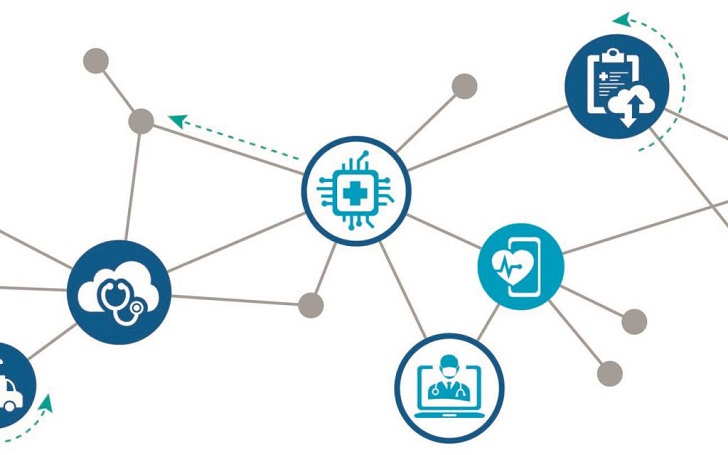
Wearable Smart Patches Are The New Innovation We All Need

Engineers at the University of California, San Diego, have created a soft, flexible skin patch that can be worn around the neck to monitor the wearer’s glucose, lactate, alcohol, and caffeine levels while also continually monitoring blood pressure and heart rate. It is the first wearable technology to simultaneously monitor numerous biochemical levels in the human body and cardiovascular signals.
What is a smart patch?
A type of wearable sensor utilized in the medical field is called a smart patch. They contain a foam component and integrated electronics to track the patient’s physiological signals, such as their pulse, and are adhered to the patient’s skin.

Liezel Labios/ UC San Diego | The patch’s popularity is continuing to grow
The trajectory of current advances is toward ever-increasing patch capability, together with enhanced comfort and continuous shrinking. This also entails using such wearable technology in a more durable, sustainable manner.
Many of the smart patches that are now used to monitor vital parameters are not particularly small and might be rather painful to wear. Additionally, the entire device, including the electronics, is merely tossed away when the patch ceases to cling to the skin.
Therefore, the goal was to develop a wearable patch that would be less wasteful, more versatile for patients, and more comfortable. It should also be highly advanced medical equipment with features that make monitoring and diagnosing patients easier.
Uses for skin patches

Casey Cephas/ Tapecon | Designed to improve sleep, energize, or provide pain relief, wellness patches are on the rise
Thanks to their reliability and convenience, electronic skin patches are excellent remote monitoring options in inpatient and outpatient cases. Currently, electronic skin patches are most commonly used in cardiac monitoring and diabetes management. But the versatile technology can be utilized for a wide variety of other uses, including
- Motion and position sensing
- Monitoring vital signs
- Temperature sensing
- Drug and cosmetic delivery
- Newborn monitoring
- Smart wound care
- General sensing
One soft skin patch that can do it all would also offer a convenient alternative for patients in intensive care units, including infants in the NICU, who need continuous blood pressure monitoring and other vital signs. These procedures currently involve inserting catheters deep inside patients’ arteries and tethering patients to multiple hospital monitors.
How it works

Solution Centre/ Pinterest | Targeted to specific needs and results, there’s likely to be a patch that will perform for you
The patch is a thin polymer sheet that can stretch to fit the skin. It has a blood pressure sensor and two chemical sensors that monitor glucose levels in interstitial fluid, caffeine and alcohol levels in perspiration, and lactate levels. Blood pressure, glucose, and lactate, alcohol, or caffeine can all be measured simultaneously by the patch, one from each sensor.
Near the patch’s center is where the blood pressure sensor is located. Conductive ink is used for soldering a group of tiny ultrasonic transducers to the patch. The transducers emit ultrasonic waves into the body when a voltage is applied to them. The sensor picks up the echoes left behind when the ultrasound waves hit an artery, and it converts the data into a reading of the blood pressure.
Two electrodes made of conductive ink are screen printed on the patch to serve as the chemical sensors. The electrode, printed on the right side of the patch, detects lactate, caffeine, and alcohol by releasing the medication pilocarpine into the skin to cause sweating and detecting the chemical compounds in the sweat. The other electrode, which detects glucose, is printed on the left side. It operates by releasing interstitial fluid from the skin with a small electrical current before detecting the amount of glucose in the fluid.
More inHealthy Trends
-
`
Are Popular Diet Trends Actually Good for Your Heart?
Diet trends grab headlines every year, promising everything from glowing skin to dramatic weight loss. But when it comes to the...
July 30, 2025 -
`
Why Are Men Taller Than Women? New Genetic Study Finds Clue
For centuries, the average height difference between men and women has been noticeable—men generally stand about five inches taller. While environment...
July 23, 2025 -
`
How Upcycled Beauty Ingredients Are Reshaping the Industry’s Future
The beauty industry is going through a big shift — and it’s not just about trends. As waste problems grow and...
July 17, 2025 -
`
A Look Inside Faith Kipyegon’s Groundbreaking Mile Run in Paris
Last week in Paris, Faith Kipyegon returned to a place she knows well: Stade Sébastien Charléty. But this time, she wasn’t...
July 9, 2025 -
`
Dairy Is Making a Major Comeback — And Health Shoppers Are Loving It
Just a few years ago, dairy sat quietly in the back seat while plant-based alternatives took the spotlight. Now, it’s stepping...
July 4, 2025 -
`
Does Aging Cause Dental Problems?
Aging doesn’t automatically mean losing teeth or developing gum disease. In fact, older adults today are holding onto more of their...
June 25, 2025 -
`
How Upcycled Ingredients Are Shaping the Future of Cosmetics
What used to end up in bins or compost heaps is now finding a new life inside skincare bottles and beauty...
June 18, 2025 -
`
Rock Legend Rod Stewart Trains to Break Sprint Record at 80
Age isn’t slowing Rod Stewart down. Known worldwide for his legendary voice, stadium-filling tours, and timeless hits like “Maggie May”, the...
June 11, 2025 -
`
The Truth Behind Detox Diets – Health Boost or Risky Trend?
It’s hard to scroll through your feed without seeing someone sipping green juice with promises of instant energy, glowing skin, and...
June 3, 2025














You must be logged in to post a comment Login